casket

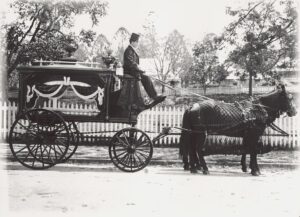 When the first cemeteries were set up, there were no automobiles, so the casket was transported by a horse or ox drawn wagon. This wasn’t exactly a luxury final ride to the final resting place, but I suppose the “honored guest” didn’t know the difference. Sometimes, when the deceased had lived way out in the country, the family chose to bury them on the property, but when they didn’t, the ride to the final resting place was a long one, and rather hard on the families, because it left so much time to just think. In many of these cases, the family had to build a casket before they could bury it. Planned funerals were very unusual. People didn’t often go to the undertaker and sit down to figure it all out, so the casket was also not planned. It gives a whole new perspective to the reason for waiting several days for the burial. We think there is a lot to plan these days…not really so much.
When the first cemeteries were set up, there were no automobiles, so the casket was transported by a horse or ox drawn wagon. This wasn’t exactly a luxury final ride to the final resting place, but I suppose the “honored guest” didn’t know the difference. Sometimes, when the deceased had lived way out in the country, the family chose to bury them on the property, but when they didn’t, the ride to the final resting place was a long one, and rather hard on the families, because it left so much time to just think. In many of these cases, the family had to build a casket before they could bury it. Planned funerals were very unusual. People didn’t often go to the undertaker and sit down to figure it all out, so the casket was also not planned. It gives a whole new perspective to the reason for waiting several days for the burial. We think there is a lot to plan these days…not really so much. 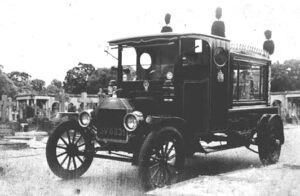
Hearses were originally “hand-drawn then horse-drawn after the decoration and weight of the hearse increased. The first electric motorized hearses were introduced to the United States in the early 1900s. Petrol-powered hearses began to be produced from 1907 and, after a slow initial uptake due to their high cost, became widely accepted in the 1920s. The vast majority of hearses since then have been based on larger, more powerful car chassis, generally retaining the front end up to and possibly including the front doors but with custom bodywork to the rear to contain the coffin.” On January 15, 1909, came the first use of an automobile hearse in a funeral.
While the first hearse was quite different from the hearses of today, it was really quite ornate. The hearses of today, might seem normal and average, but in some instances, they can be quite unusual too. One hearse I found, really surprised me. If you happen to be a motorcycle fan, you might be interested to know that there is actually a motorcycle hearse. It is a one rider affair, with a very interesting “sidecar” to hold the casket. It is a 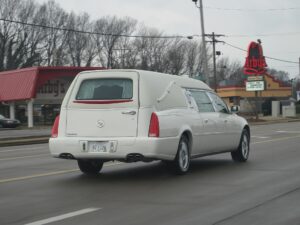
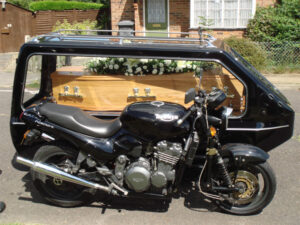 far cry from the original horse-drawn version, and definitely different from the hand cart version. While funerals these days are unique to the deceased, and that is what makes them beautiful, they were often very plain in times past. Everyone pretty much had the same service with the same songs, and the same words spoken. These days, funerals…planned mostly by the family, are very personalized, sometimes right down to the type of hearse.
far cry from the original horse-drawn version, and definitely different from the hand cart version. While funerals these days are unique to the deceased, and that is what makes them beautiful, they were often very plain in times past. Everyone pretty much had the same service with the same songs, and the same words spoken. These days, funerals…planned mostly by the family, are very personalized, sometimes right down to the type of hearse.
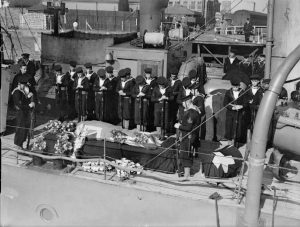
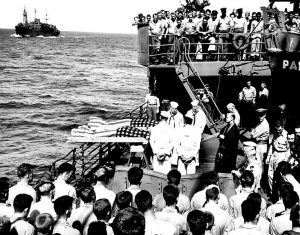 Most of us really don’t want to think about our own funeral, but when men are at war, death and a funeral become a subject they have to think about. They don’t want to, but they have no guarantee that they will return home, so they are faced with the possibility of death every day. In the Navy, during wartime, at least in the past, if not currently, it was common practice to bury the casualties at sea. That is such a hard concept for me, and yet there isn’t really anything wrong with it. I guess that having no grave site to visit is probably the thing that is bothering me the most. It’s not that I spend days and hours at the cemetery, but rather that I know exactly where my loved ones are laid to rest, or where I will be.
Most of us really don’t want to think about our own funeral, but when men are at war, death and a funeral become a subject they have to think about. They don’t want to, but they have no guarantee that they will return home, so they are faced with the possibility of death every day. In the Navy, during wartime, at least in the past, if not currently, it was common practice to bury the casualties at sea. That is such a hard concept for me, and yet there isn’t really anything wrong with it. I guess that having no grave site to visit is probably the thing that is bothering me the most. It’s not that I spend days and hours at the cemetery, but rather that I know exactly where my loved ones are laid to rest, or where I will be.
Burials at sea have been going on as long as men have been going to sea. For logical reasons, a body could not be kept on board a ship for the remainder of the cruise, so the death had to be dealt with. In early days, the body was wrapped in a shroud, usually made of sailcloth, but later caskets were also used. If the family has decided to use a casket instead of a shroud for the burial at sea, the casket must be a metal casket, because it must be able to deteriorate in the marine environment. I suppose that makes sense, because eventually ships and planes return to the environment around them. The sea eventually claims what doesn’t belong there naturally. Of course, the timeframe involved in the deterioration of the casket would be well beyond the lifetime of the families, so I guess that would make it easier to think about it.
Military burials at sea are performed with much pomp and circumstance. The honor of the soldier is held in the highest regard. The personnel who participate or even attend the services must wear the Uniform of the Day. The commanding officer tries to have a chaplain of the appropriate faith perform the ceremony, but if that is not an option, the service may be read by the commanding officer or an officer designated by him/her. The service is much like a church service, with a eulogy, firing squad salute, pall bearers, and a flag ceremony. When everything is finished, the body is moved to the side of the ship of a plank and then the plank is raised so that the casket or shrouded body slides off into the sea.
Of course, when a ship sinks, there is an instant burial at sea for all who do not survive. Many times the ship is not found for years, so the ship becomes the casket for all those who lost their lives. The family can seek to have the body recovered when the ship is found, but often that does not happen. The USS Arizona is probably 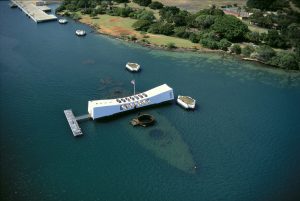
 one of the most well known casket ships in the world, and while it was easy to see and get to, many of the families chose to leave their loved ones there. The USS Arizona went down with 1,177 Sailor and Marines on board. The ship marks the final resting spot of 1,102 of the original 1,177. Also, beginning in 1982, the US Navy has allowed surviving crew members to be “buried” on the Arizona.
one of the most well known casket ships in the world, and while it was easy to see and get to, many of the families chose to leave their loved ones there. The USS Arizona went down with 1,177 Sailor and Marines on board. The ship marks the final resting spot of 1,102 of the original 1,177. Also, beginning in 1982, the US Navy has allowed surviving crew members to be “buried” on the Arizona.

